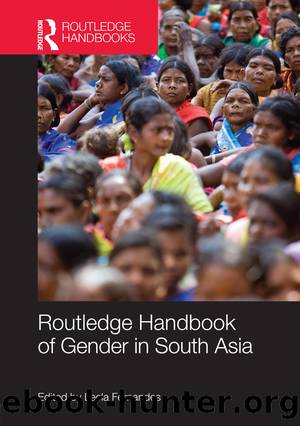Routledge Handbook of Gender in South Asia by Fernandes Leela

Author:Fernandes, Leela.
Language: eng
Format: epub
ISBN: 9781317907060
Publisher: Taylor & Francis (CAM)
A Santosh Nagar women’s ritual: ‘that throwntogetherness’
Sunday, December 5, 2010 (Dark Moon of Margashira): Three women bearing worship trays quietly gather, late one morning, in a spacious private courtyard in Santosh Nagar. The courtyard lies close to the outer edge of our neighborhood. I have come to join the three women – each in the final year of a three-year vow to fast monthly on the dark moon. Their collective performance of a dark moon worship has been a recurrent event for over two years. All three women are between 40 and 50 years of age, and live in Santosh Nagar because their husbands’ working lives deposited them in this neighborhood years ago.
Accompanying me is another neighbor, Bhoju’s middle daughter Chinu Gujar, a first-year unmarried college student in her late teens. She and her elder sister Madhu sometimes assist my fieldwork when they can take time away from studies and domestic chores. Chinu is not fasting but does participate in the prayers. Our hostess, Pushpa, is a wealthy widow from an agricultural community with no deep roots in Jahazpur; our ritual expert Lakshmi is a cheerful Brahmin. The third participant, another close neighbor, is Gita, in whose life sorrow has provoked unusual devotional fervor. She belongs to an S.T. (‘Scheduled Tribe’) group, populous and politically powerful in this region.
A mixed-caste group of neighbor women worshiping together was not uncommon in Ghatiyali, the village where I conducted all my earlier ethnographic research. However, as I gradually discover, the lives of these Santosh Nagar women thrown together through domestic proximity and devotional predilection are distinctively inflected by the time and place: the second decade of the twenty-first century and the eclectically mixed ‘suburban’ colony where they live. The household where we gather is doubly unusual. Not only is it the sole private home in Santosh Nagar containing its own small temple; but this open air temple dedicated to Lord Shiva also houses not just the usual figures of Parvati, Ganesh, Skanda (Kartikkeya) and Nandi ranged around a central aniconic Shiva lingam (an assemblage found at small Shiva shrines throughout the region), but a fifth: the large marble bust of our hostess Pushpa’s late husband.
My research this year is not focused on women’s worship or on stories. I am trying to learn about senses of place in a small town: about identity, locality, belonging – abstractions difficult to encounter on the ground. Compared with pursuing these ineffables, nothing seems easier than pressing ‘record’ at a women’s ritual and sitting back to enjoy the stories.8 The dark moon fast the three women have undertaken is called ‘tīn panotī vrat’ or ‘three-panoti vow’ – a vow that protects from undesirable planetary emanations.9 Lakshmi volubly explains to me the vow’s major features. For three years on every dark moon (that is, once a month), the person who has made this vow must eat only a designated grain: barley in year 1; rice in year 2; sesame in year 3. The practice requires a total fast before
Download
This site does not store any files on its server. We only index and link to content provided by other sites. Please contact the content providers to delete copyright contents if any and email us, we'll remove relevant links or contents immediately.
| Africa | Americas |
| Arctic & Antarctica | Asia |
| Australia & Oceania | Europe |
| Middle East | Russia |
| United States | World |
| Ancient Civilizations | Military |
| Historical Study & Educational Resources |
The Story of China by Michael Wood(929)
Mr. Selden's Map of China by Timothy Brook(775)
Philippines--Culture Smart! by Culture Smart!(669)
Heroic Hindu Resistance To Muslim Invaders (636 AD to 1206 AD) by Sita Ram Goel(657)
Akbar: The Great Mughal by Ira Mukhoty(651)
The Meaning of India by Raja Rao(631)
Vedic Physics: Scientific Origin of Hinduism by Raja Ram Mohan Roy(624)
Food of India by unknow(618)
Banaras by Diana L. Eck(614)
India--Culture Smart! by Becky Stephen(602)
China Unbound by Joanna Chiu(602)
First Platoon by Annie Jacobsen(601)
Mao's Great Famine: The History of China's Most Devastating Catastrophe, 1958-1962 by Frank Dikötter(594)
North of South by Shiva Naipaul(591)
Insurgency and Counterinsurgency by Jeremy Black(565)
How to Be a Modern Samurai by Antony Cummins(563)
A History of Japan by R.H.P. Mason & J.G. Caiger(562)
The Genius of China: 3,000 Years of Science, Discovery, and Invention by Robert Temple(562)
The Digital Silk Road by Jonathan E. Hillman(550)
